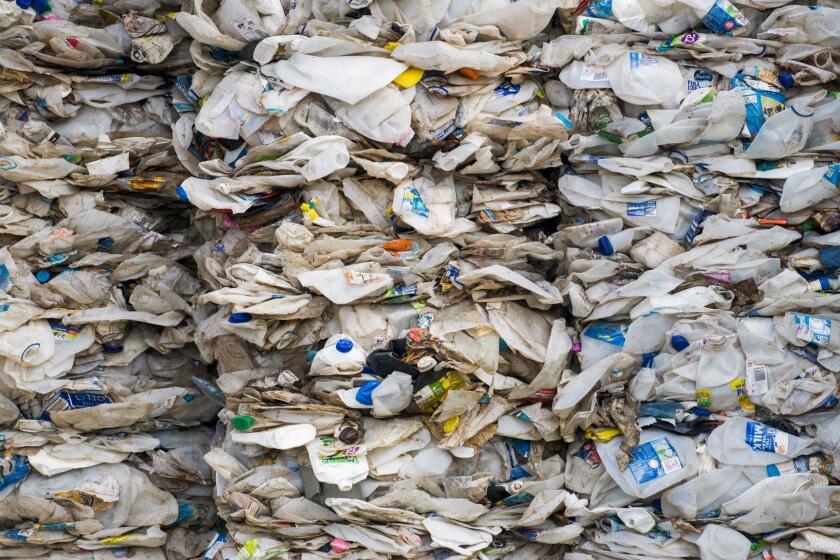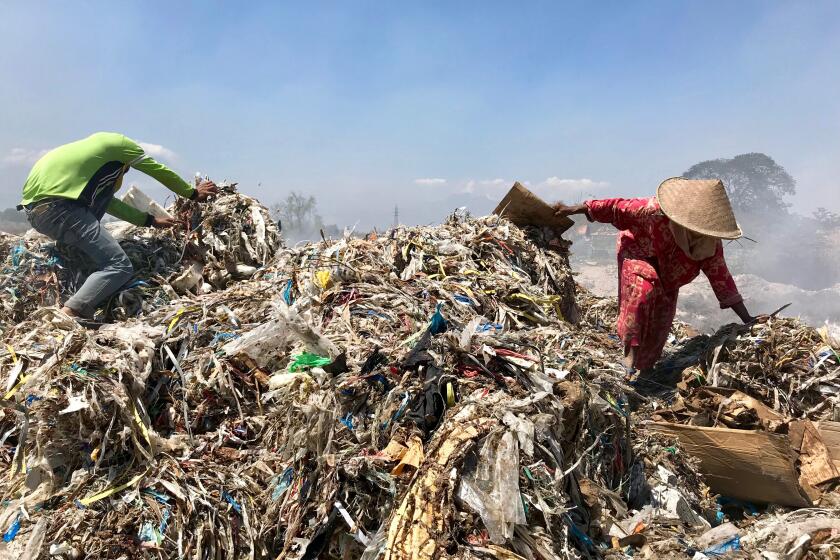The tiny plastic packages that are fueling Asia’s waste crisis
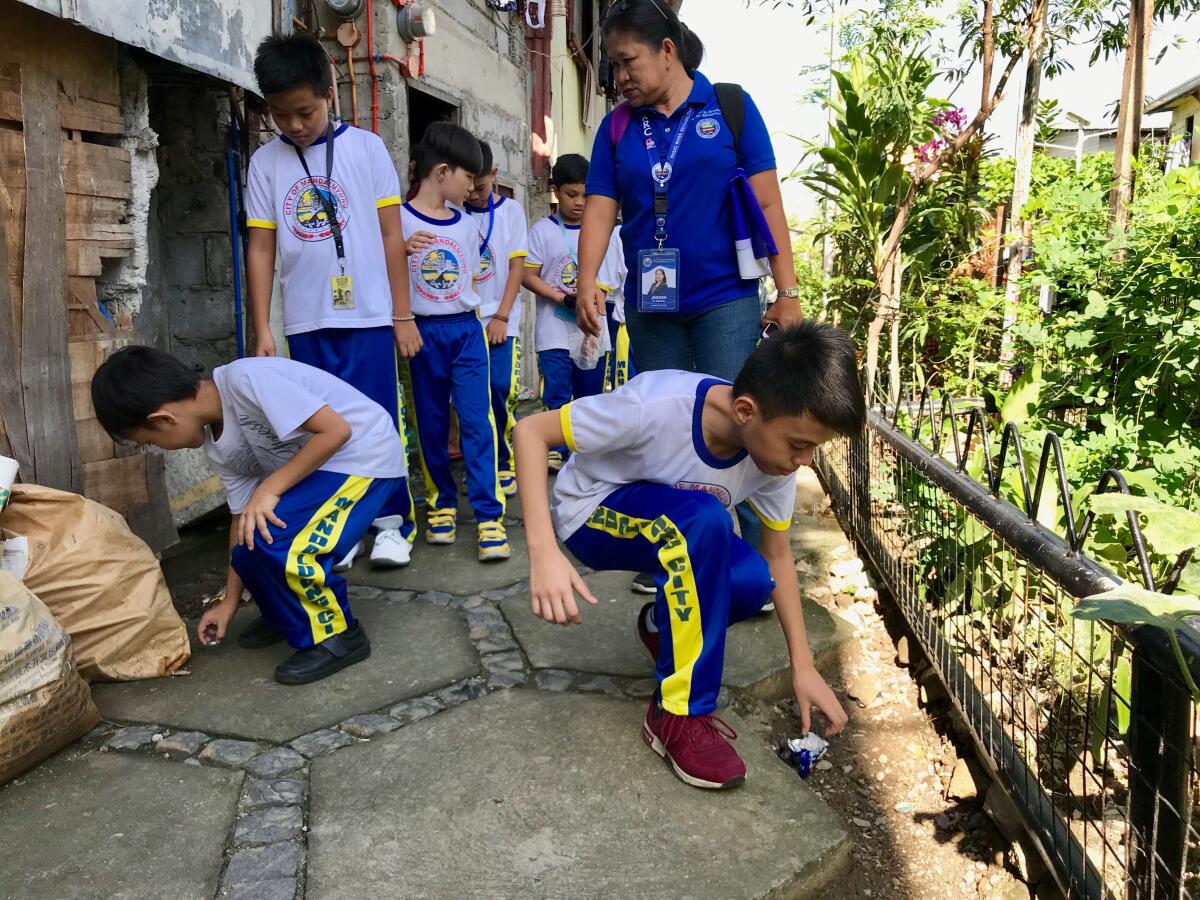
- Share via
MANILA — Two dozen children fanned out along a creek near their elementary school, filling sacks with litter left by residents of the concrete shacks lining the waterway.
When they’d finished the morning cleanup, the students emptied a large garbage bag to study its contents. A stream of shiny plastic scraps spilled onto the school’s driveway.
Bearing the names of familiar international brands of coffee creamer, biscuits, laundry detergent and candy, the discarded packaging illustrated one of the biggest environmental challenges facing Asia’s booming cities. The palm-sized packets known as sachets have exploded in emerging economies, allowing low-income consumers to buy single servings of almost any product.
But the packaging cannot be easily recycled, and in cities like Manila with spotty waste collection, the used pouches have piled up in empty fields, collected in sewers and spilled into rivers and oceans — adding to a glut of plastic waste that Asian countries have begun to regard as an environmental crisis.
“For people who live on a day-to-day basis, sachets are a reality of life — but they are also one of the biggest waste problems we face,” said George Oliver De La Rama, a spokesman for the Pasig River Rehabilitation Commission, the government agency overseeing the cleanup this month.
As environmental groups sound the alarm over harmful plastic debris, Western consumer goods companies are searching for ways to reduce the use of sachets and make them easier to recycle. In Manila, manufacturers are investing in plans to turn used plastic into bricks, tiles and classroom chairs.
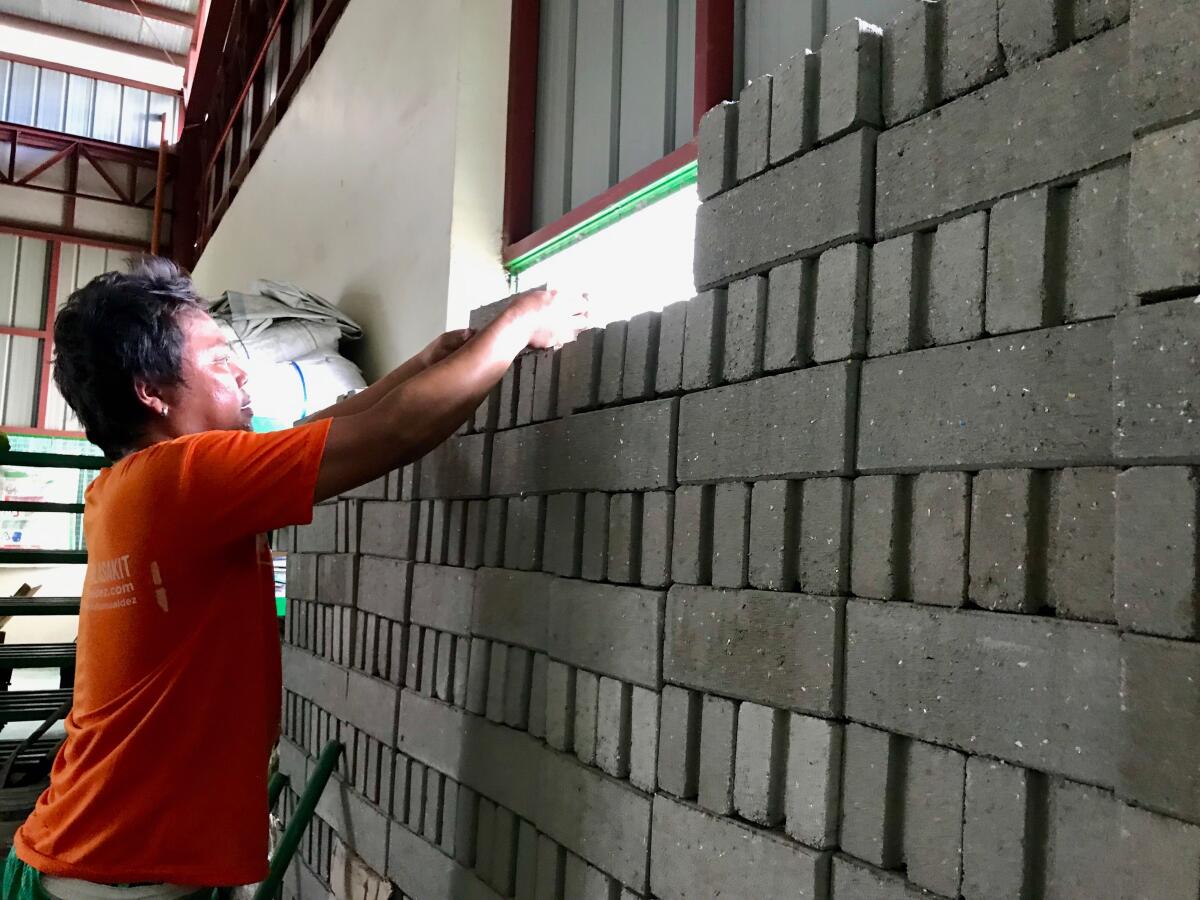
Meanwhile, the number of sachets in the environment continues to explode.
The Philippines, an archipelago with more than 105 million people spread across 7,600 islands, consumes about 59.7 billion sachets every year, according to the Global Alliance for Incinerator Alternatives, or GAIA, an advocacy group. That’s enough to cover all of metropolitan Manila — or roughly half of Los Angeles — in one foot of plastic.
For consumer goods giants, sachets were “a brilliant marketing tactic to capture the low-income market and good for brand visibility, but no one thought of the consequences,” said Von Hernandez, a Philippine environmental activist and global coordinator of Break Free From Plastic, an advocacy group.
When the MV Bavaria cargo ship chugged out of a Philippine port one morning last month carrying 69 containers of rotted Canadian garbage, it didn’t just end a messy diplomatic spat between the two countries.
Since Americans Harold Ross and Yale Kaplan patented the flexible, single-use plastic food pouch in 1955 — making the first ketchup and soy sauce packets possible — multinational corporations have used sachets to sell tiny quantities of every conceivable product.
The first to realize the potential of sachets in Asia was a family-run Indian company called CavinKare, which in the early 1980s introduced 0.3-ounce pouches of shampoo, good for one wash.
Sold for pennies, it was such a hit with villagers — some of whom had never used shampoo before — that competitors began packaging salt, talcum powder, toothpaste, soap and skin cream in small, throwaway packages.
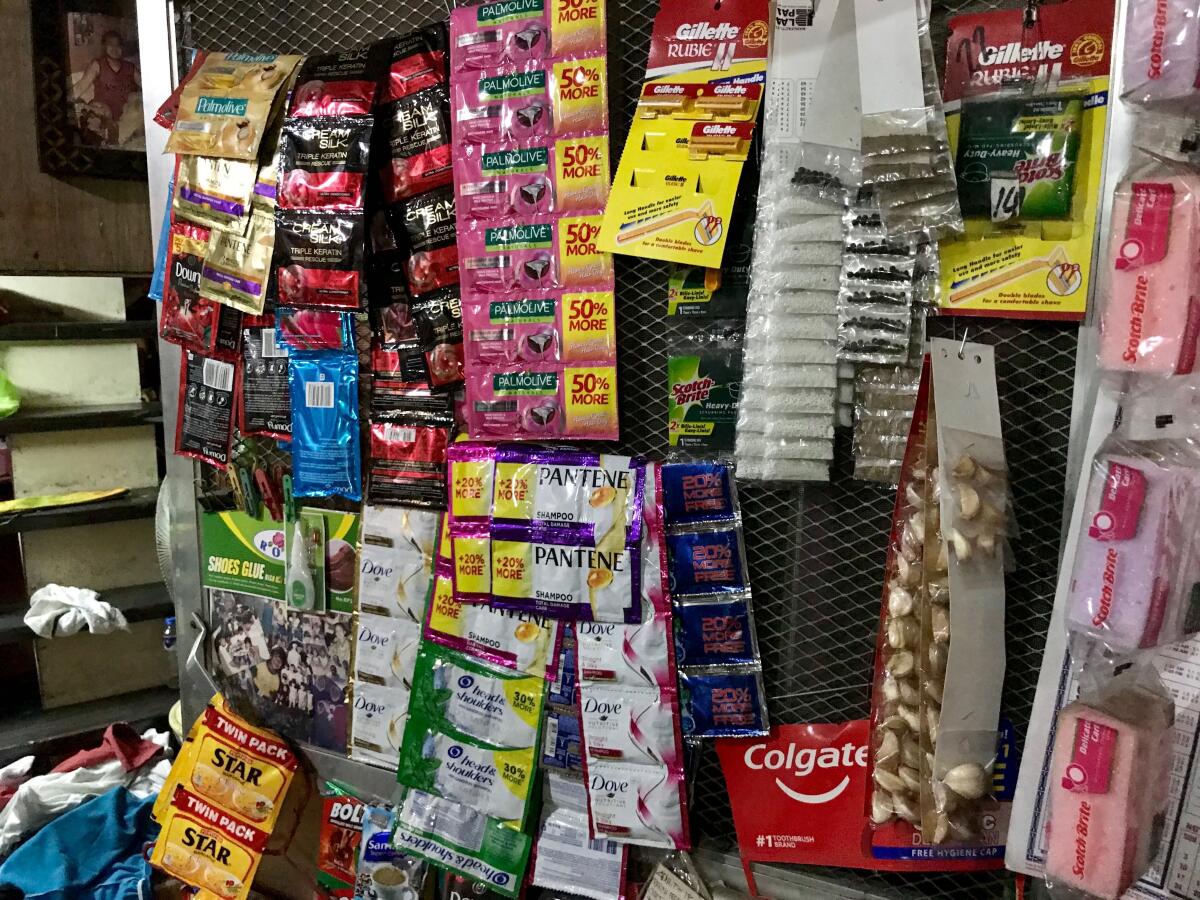
Management expert C.K. Prahalad, in his 2004 book “The Fortune at the Bottom of the Pyramid,” wrote that companies could realize $13 trillion in profits every year by selling to the half of the globe that lived on less than $2 a day. A sachet revolution rippled across the developing world: brightly colored packets with corporate logos dangling from roadside stalls and market shelves everywhere, promising safe and hygienic products for all.
But all those pint-sized pouches ushered in a waste nightmare.
Their complex construction — multiple layers of polymers, aluminum and films designed to keep products fresh in soggy tropical heat — renders sachets almost impossible to recycle. Although small-scale initiatives in the Philippines and elsewhere are attempting to repurpose sachets, the vast bulk of the waste must be dumped in landfills or incinerated — but the low-income neighborhoods that rely most on the pouches are often the ones least likely to have reliable trash collection.
In Philippine cities, waste pickers who gather plastic for recycling leave sachets behind because they have no value.
“The industry knew that there was little collection or recycling capacity when they started selling here,” Hernandez said. “We are shouldering the burden of their product — they are profiting at our expense.”
Scientists Laurent Lebreton and Anthony Andrady recently estimated that in 2015, metropolitan Manila — a coastal megacity of more than 15 million people — generated at least 810,000 metric tons of plastic litter that wasn’t properly disposed, the most of any urban area in the world.
In their analysis, the Philippines trailed only China and India in the quantity of plastic debris it allowed to seep into the ocean, where scientists believe it is endangering aquatic species and contaminating the food chain.
“They’re very light, easily blown and carried by the wind and the water — so there are coastal communities that are just inundated with sachets,” said Beau Baconguis, regional plastics campaigner for GAIA.
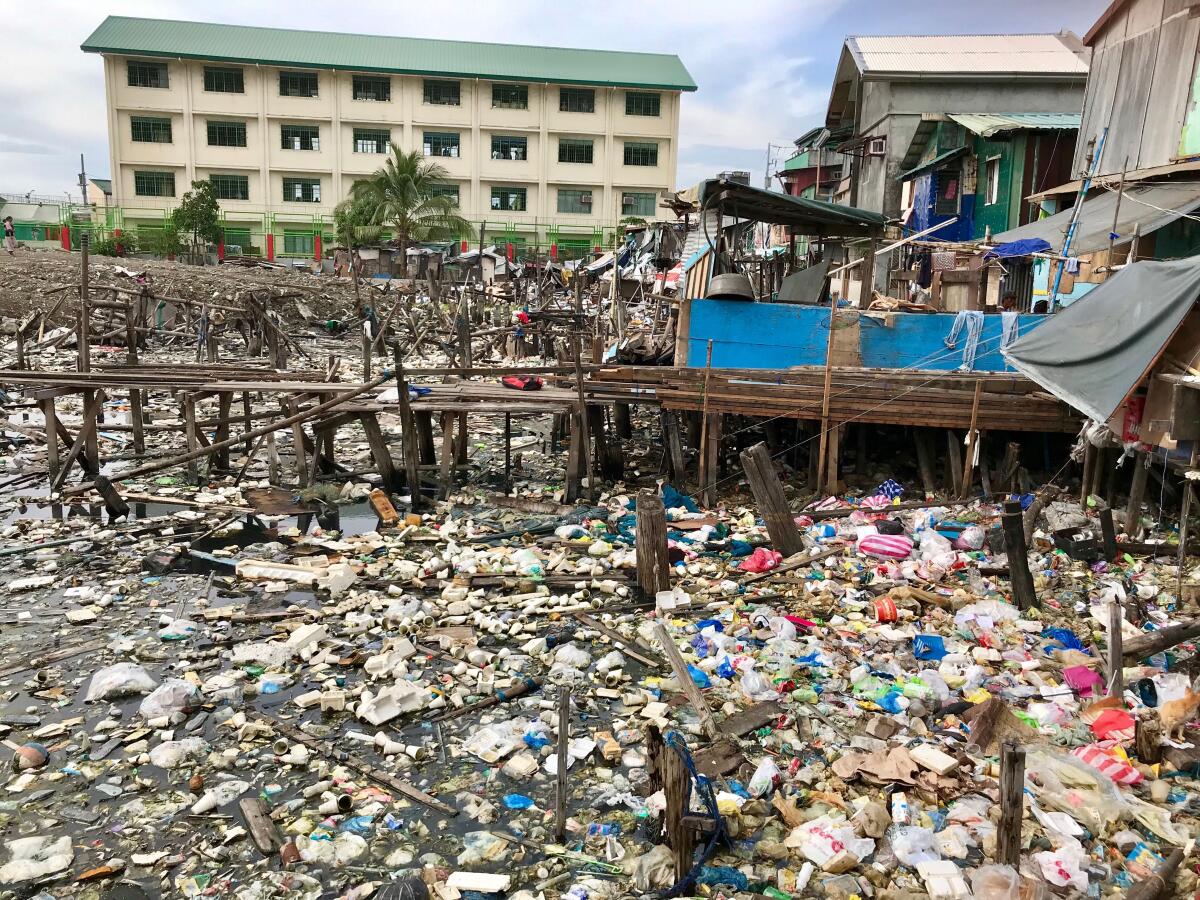
The group recently analyzed collection efforts in 21 Philippine cities and found that sachets made up more than half of all household plastic waste. The lion’s share of consumer packaging came from just a handful of companies — including Nestle, Unilever and Procter & Gamble.
Each company has announced plans to phase out hard-to-recycle plastics over the next decade. Unilever — maker of Dove and Vaseline — has said it will reduce its use of plastic by 2025 by enhancing collection efforts, increasing the use of paper and other alternatives and introducing new delivery models such as refill stations.
Last month, the company introduced an incentive program in Manila that lets people trade in used sachets for vouchers for new Unilever products.
“Sachets are one of the most efficient ways to deliver these products, but when our packaging ends up in the environment, that’s not OK with us,” said Ed Sunico, vice president for sustainable business at Unilever Philippines.
But a pilot shampoo refill project last year showed little success, environmental groups said, because Unilever placed the dispensers at upscale Manila shopping malls — not ideal to reach customers who buy 10-cent sachets.
“Until they show these can be rolled out at sari-sari stores” — the ubiquitous neighborhood stalls where most Filipinos do their daily shopping — “this all just looks like a show,” Hernandez said.
Asia’s crackdown on plastic waste, aimed at protecting the environment, is bad news for small-time recyclers in Indonesia who make a living sorting foreign garbage.
Activists say the Philippine government has failed to enforce its waste management law, which requires local governments to collect trash from every neighborhood and prohibits manufacturers from using “non-environmentally acceptable” packaging material.
Philippine officials have resisted toughening rules around plastic products, saying they don’t want to harm consumers. At an event on marine pollution this year, Ricardo Calderon, a senior environment department official, said “the sachet economy … is basically part of [economic] development.”
Despite environmental concerns, forecasters believe the global market for plastic packaging will continue to grow by more than 3% annually, reaching $269 billion by 2024, according to one analysis.
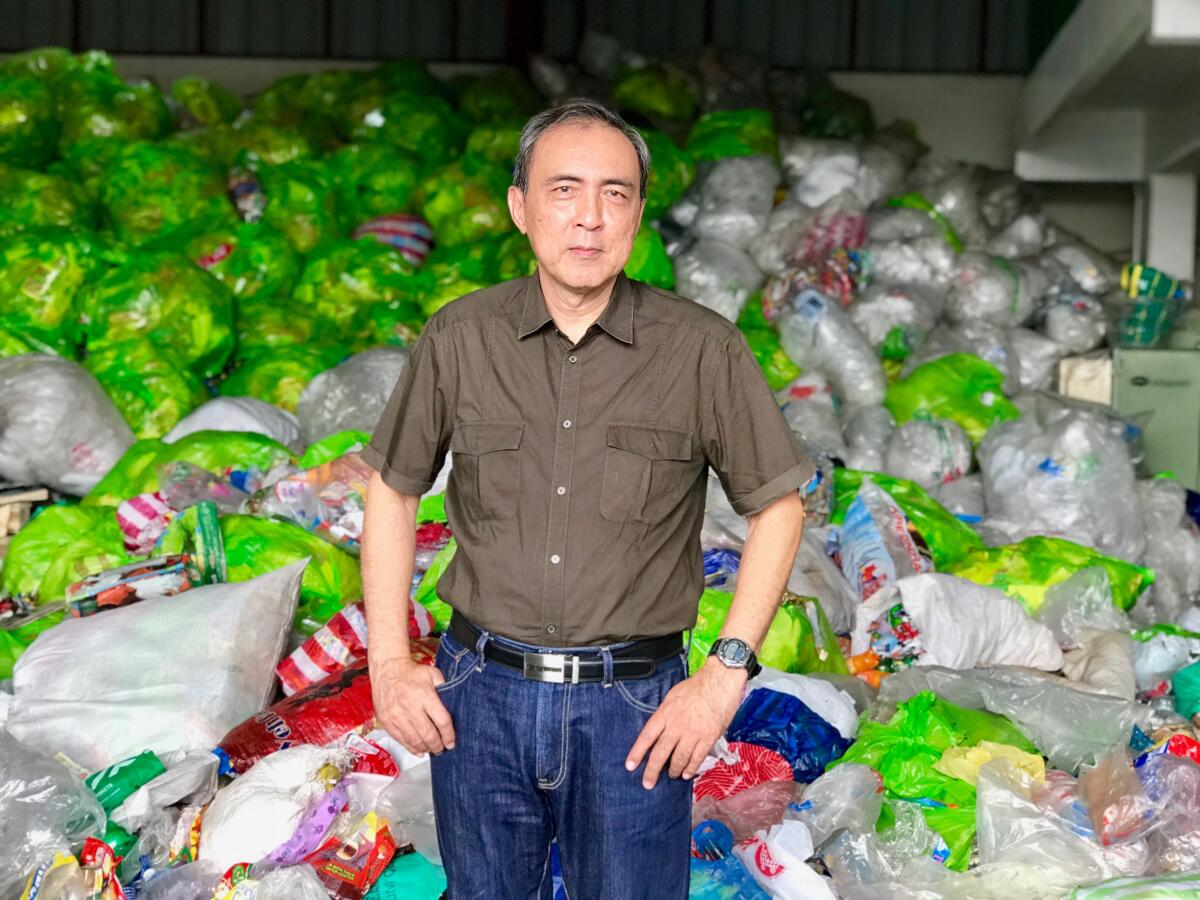
“You can’t change from plastic packaging without a clear substitute,” said Bert Guevara, vice president of the Philippine Alliance for Recycling and Materials Sustainability, a consortium of manufacturers and industry groups that includes Unilever and Coca-Cola. The group opposes proposals to ban single-use plastics or restrict sales of sachets.
“We have over-demonized plastic, and now people want to solve the problem in one or two years,” he said. “We are pushing for science-based solutions.”
In the industrial Manila suburb of Parañaque, the recycling alliance and local authorities recently opened a factory to manufacture parking bumpers and bricks using shredded sachets.
The “eco-bricks” — made of sand and gravel, mixed with 15-18% sachets — are said to be five times as strong as standard bricks, Guevara said, and could soon be used in city construction.
Over the noise of jets landing at Manila’s nearby international airport, Guevara touted the potential of a 20-foot mound of sachets rising from one corner of the tin-roofed warehouse. Once it gets going, he said, the facility could process one ton of sachets per day.
That sounds like a lot, but consider this: According to government statistics, the Philippines generates more than 4,600 tons of plastic waste daily.
“We have to start somewhere,” Guevara said.
More to Read
Updates
4:31 p.m. Nov. 10, 2019: In a previous version of the story, a factory in the industrial Manila suburb of Parañaque was said to have been opened by GAIA and local authorities. The story has been changed to reflect that the factory was opened by the Philippine Alliance for Recycling and Materials Sustainability and local authorities.
Sign up for Essential California
The most important California stories and recommendations in your inbox every morning.
You may occasionally receive promotional content from the Los Angeles Times.
